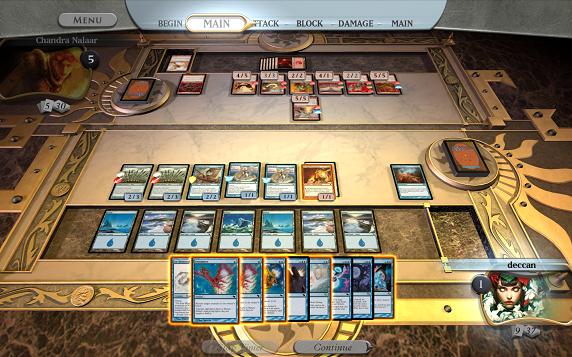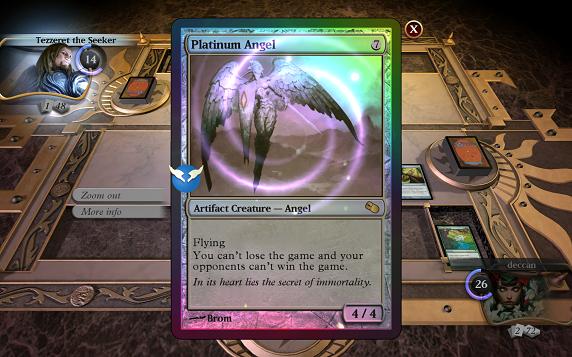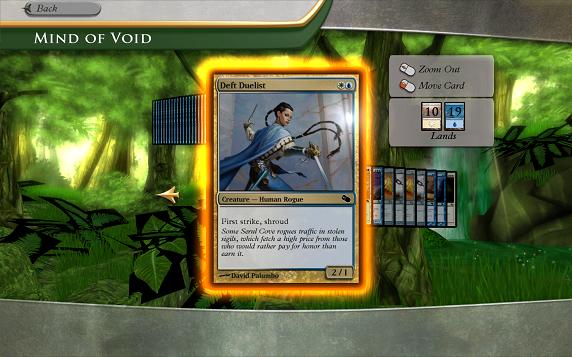
Duels of the Planeswalkers is a stripped down video game version of Magic: The Gathering made to be simple enough to appeal to the console crowd. The game uses preconstructed decks and there’s no real storyline or anything. The single-player campaign consists of a series of duels against the AI.You start out with a small selection of decks against easy enemies, but over time, you gain access to more decks and face off against enemies with better decks as well.
There’s no real deck construction in here. As you win games, you unlock additional cards that are automatically added to the current deck you’re using. You can choose to include or exclude these unlocked cards from the deck but you’re never allowed to remove any cards from the base set. You’re not even allowed to tweak the land distribution. Land cards are automatically added to the deck depending on how many extra cards you choose to include in it. My thoughts:
- Despite an initial learning curve, the interface is excellent. You can scroll through a large selection of cards pretty effortlessly, zoom in to take a close-up look at an individual card and then zoom back out again quickly etc. It takes a bit of practice to get used to hitting the stop timer button when you need to play an instant effect, but I’m not completely happy with how quickly skips over a main turn phase if you only have instants to play, but overall I find that it strikes a good balance between speed and ease of use.
- The big exception of course is that the game auto-taps lands for mana, and there’s no option to do it manually. The game tries to intelligently auto-tap in such a way as to maximize your ability to play the cards left in your hand but manually doing it is always better. It’s especially bad when you have permanents in play that you can feed mana to as the game doesn’t know enough to reserve mana for them. Auto-tapping is a nice feature that makes play go faster but there’s no excuse for not including an option to disable it when you need to.

- The included decks are mostly very interesting and play differently enough to matter. Ignore the initial set of monocolor decks however. They’re too simple and weak to be interesting for long so it’s not worth wasting time unlocking cards for them. Any of the later decks are better. Surprisingly, the designers manage to include tri-color decks as well even though the game doesn’t have any dual lands and they actually work quite well. My favorite deck at the moment is the green-black elf deck. All the elves start out small and but can grow very big with the right cards out.
- The lack of real deckbuilding makes this a strictly casual game but there’s still enough variety to have fun for a while. The cards are all from the modern era of Magic: The Gathering, so don’t expect to see moxes of Power Nine cards here. But to people like who’ve been away from the game for a while now, the power level of the modern creature cards is shocking enough. A 5/4 creature for 3 mana and no downsides? Ouch!
- Other components include online multiplayer, which works very smoothly, and a very fun Challenge mode which reminds me of an old feature in the now defunct Duelist magazine. These are intricate puzzles in which you need to play cards and activate effects in a specific and often unintuitive sequence to win. It’s a pity that the game includes relatively few of these puzzles.
- The AI is surprisingly competent given how complex Magic: The Gathering can get, but it’s far from perfect. It’s very cute for example to see the AI play Howling Mines when I’m running a deck that’s meant to kill it by running it out of cards. But the most frustrating thing is that the game seems to give the AI a break at higher difficulty levels by making sure that it always draws the right land cards, so you almost never seen the AI get mana screwed.
Anyway, this is still a solid game and represents one of the cheapest ways of playing Magic: The Gathering, given how expensive playing with physical cardboard can get. The lack of true deckbuilding means there’s not much legs in it in single-player mode but it’s a good, casual game for multiplayer. It’s a pity that in order to be competitive you need to grind for so long against the AI to unlock all the cards or pay more to buy unlocks. I guess just like the real thing, it’s how they make sure that you pay the dues before you get to play with all the goodies.

Leave a Reply